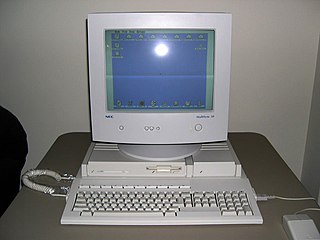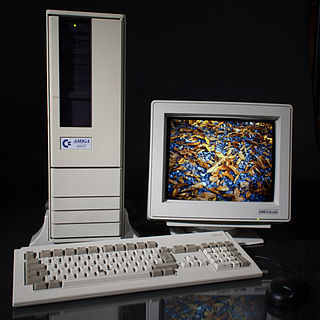
Amiga is a family of personal computers introduced by Commodore in 1985. The original model is one of a number of mid-1980s computers with 16- or 16/32-bit processors, 256 KB or more of RAM, mouse-based GUIs, and significantly improved graphics and audio compared to previous 8-bit systems. These systems include the Atari ST—released earlier the same year—as well as the Macintosh and Acorn Archimedes. Based on the Motorola 68000 microprocessor, the Amiga differs from its contemporaries through the inclusion of custom hardware to accelerate graphics and sound, including sprites and a blitter, and a pre-emptive multitasking operating system called AmigaOS.

The Amiga 500, also known as the A500, was the first popular version of the Amiga home computer, "redefining the home computer market and making so-called luxury features such as multitasking and colour a standard long before Microsoft or Apple sold these to the masses". It contains the same Motorola 68000 as the Amiga 1000, as well as the same graphics and sound coprocessors, but is in a smaller case similar to that of the Commodore 128.

Industry Standard Architecture (ISA) is the 16-bit internal bus of IBM PC/AT and similar computers based on the Intel 80286 and its immediate successors during the 1980s. The bus was (largely) backward compatible with the 8-bit bus of the 8088-based IBM PC, including the IBM PC/XT as well as IBM PC compatibles.

The Original Chip Set (OCS) is a chipset used in the earliest Commodore Amiga computers and defined the Amiga's graphics and sound capabilities. It was succeeded by the slightly improved Enhanced Chip Set (ECS) and the greatly improved Advanced Graphics Architecture (AGA).
Direct memory access (DMA) is a feature of computer systems that allows certain hardware subsystems to access main system memory independently of the central processing unit (CPU).

The Amiga 3000, or A3000, is a personal computer released by Commodore in June 1990. It is the successor to the Amiga 2000 and its upgraded model Amiga 2500 with more processing speed, improved graphics, and a new revision of the operating system.

The Amiga 2000, or A2000, is a personal computer released by Commodore in March 1987. It was introduced as a "big box" expandable variant of the Amiga 1000 but quickly redesigned to share most of its electronic components with the contemporary Amiga 500 for cost reduction. Expansion capabilities include two 3.5" drive bays and one 5.25" bay that could be used by a 5.25" floppy drive, a hard drive, or CD-ROM once they became available.
Chip RAM is a commonly used term for the integrated RAM used in Commodore's line of Amiga computers. Chip RAM is shared between the central processing unit (CPU) and the Amiga's dedicated chipset. It was also, rather misleadingly, known as "graphics RAM".
Amiga Advanced Graphics Architecture (AGA) is the third-generation Amiga graphic chipset, first used in the Amiga 4000 in 1992. Before release AGA was codenamed Pandora by Commodore International.

The Amiga 4000, or A4000, from Commodore is the successor of the Amiga 2000 and Amiga 3000 computers. There are two models: the A4000/040 released in October 1992 with a Motorola 68040 CPU, and the A4000/030 released in April 1993 with a Motorola 68EC030.
Autoconfig is an auto-configuration protocol of Amiga computers which is intended to automatically assign resources to expansion devices without the need for jumper settings. It is analogous to PCI configuration through ACPI.

The NCR 53C9x is a family of application-specific integrated circuits (ASIC) produced by the former NCR Corporation and others for implementing the SCSI bus protocol in hardware and relieving the host system of the work required to sequence the SCSI bus. The 53C9x was a low-cost solution and was therefore widely adopted by OEMs in various motherboard and peripheral device designs. The original 53C90 lacked direct memory access (DMA) capability, an omission that was addressed in the 53C90A and subsequent versions.

The Atari TT030 is a member of the Atari ST family, released in 1990. It was originally intended to be a high-end Unix workstation, but Atari took two years to release a port of Unix SVR4 for the TT, which prevented the TT from ever being seriously considered in its intended market.
Released as the expansion bus of the Commodore Amiga 3000 in 1990, the Zorro III computer bus was used to attach peripheral devices to an Amiga motherboard. Designed by Commodore International lead engineer Dave Haynie, the 32-bit Zorro III replaced the 16-bit Zorro II bus used in the Amiga 2000. As with the Zorro II bus, Zorro III allowed for true Plug and Play autodetection wherein devices were dynamically allocated the resources they needed on boot.
The AAA chipset was intended to be the next-generation Amiga multimedia system designed by Commodore International. Initially begun as a secret project, the first design discussions were started in 1988, and after many revisions and redesigns the first silicon versions were fabricated in 1992–1993. The project was stymied in 1993 based on a lack of funds for chip revisions.

The Amiga 4000T, also known as A4000T, is a tower version of Commodore's A4000 personal computer. Using the AGA chipset, it was originally released in small quantities in 1994 with a 25 MHz Motorola 68040 CPU, and re-released in greater numbers by Escom in 1995, after Commodore's demise, along with a new variant which featured a 50 MHz Motorola 68060 CPU. Despite the subsequent demise of Escom, production was continued by QuikPak in North America into at least 1998.

Kickstart is the bootstrap firmware of the Amiga computers developed by Commodore International. Its purpose is to initialize the Amiga hardware and core components of AmigaOS and then attempt to boot from a bootable volume, such as a floppy disk. Most Amiga models were shipped with the Kickstart firmware stored on ROM chips.

The Amiga 1200, or A1200, is a personal computer in the Amiga computer family released by Commodore International, aimed at the home computer market. It was launched on October 21, 1992, at a base price of £399 in the United Kingdom and $599 in the United States.

AMD Lance Am7990 IEEE 802.3 Ethernet media access controller (MAC) controller were introduced in 1985. Its architecture is the basis for AMD's PCnet Family of highly integrated single-chip Ethernet controllers. The one exception is the Am79C940 MAC. The Am7990 chip was fabricated in NMOS technology and has no integrated Manchester encoder/decoder (ENDEC) nor does it have an integrated 10BASE-T transceiver.
Sysinfo is a shareware program written completely in Assembler for the Motorola 68k equipped Amiga computers to benchmark system performance. Sysinfo shows which version of system software is present in ROM, which hardware is present, and which operating mode the hardware uses.
















